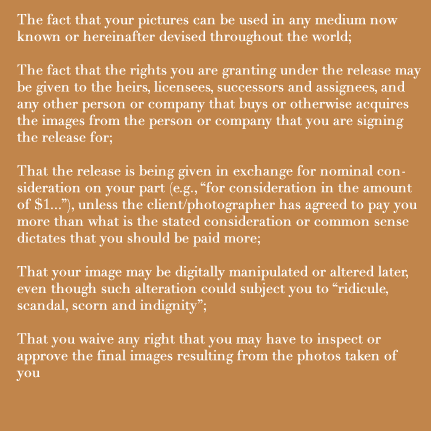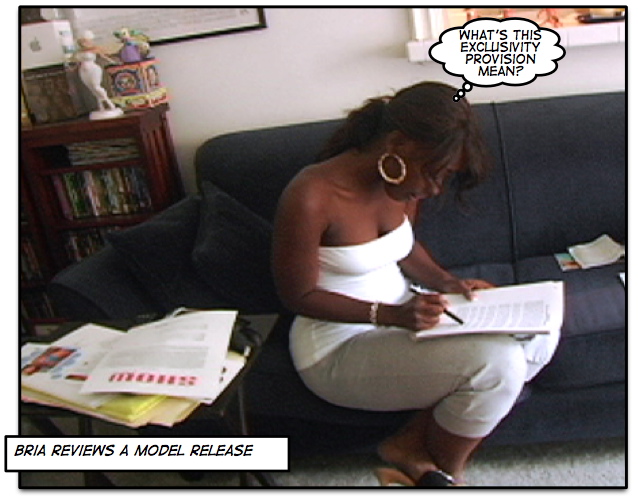Indochine's Top Shelf
Indos Place
Model Release
Liability for Misappropriating Model's Image for Commercial Purpose
12/03/09 16:50 Model AdviceModel Advice
NOTE: This
article has been significantly edited as of January
24, 2010.
Just a little comment about the recent Judge Judy case where it was ruled that a club promoter who used an urban model’s picture on promotional fliers was liable for $5,000 in damages to the model.
First of all, it’s important to note Judge Judy is sitting in small claims court/arbitration, so that case has no real precedential value (e.g., no other courts will rely on that ruling as the basis for future rulings).
However, the general premise of that case is true – you can’t use someone’s image for a commercial purpose, which means to make money, without his or her written consent. That’s why 50 Cent is suing World Star Hip Hop. They used his image on their website in such a way that it looked like he was affiliated with their site without his written consent. This gave them greater traffic and more ad revenues, which is a commercial purpose.
So what does this mean for your average club promoter, graphic designer, blogger, etc? It means you should get permission from the copyright holder of an image and/or the model before putting it on a flier or otherwise using it to make money. This recent Judge Judy episode will likely inspire more models to act on this type of misappropriation more often.
• What are the damages?
In the Judge Judy case she slapped the club promoter with the maximum allowable damages in small claims - $5000. In reality, damages could be difficult to prove and might have been less.
In California, for example, “The injured party may recover (1) the greater of $ 750 or actual damages, and (2) any profits attributable to the unauthorized use and not accounted for in computing damages. In establishing profits, the burden is on the injured party to prove the gross revenue, and on the violator to prove deductible expenses. The injured party may also recover punitive damages, and the prevailing party is entitled to attorneys' fees and costs.” (C.C. § 3344(a).) That's a lot to digest, but the reality is that it would be difficult for a model prove what revenues a club made due to using her image on a flier without hiring a forensic accountant. Also, since there are no attorneys allowed in small claims court, there would be no legal fees recoverable, although some filing fees might be allowed. So that might mean just $750 in damages for the club promoter (in California).
• Exception for Newsworthy Matters or Matters of Public Interest
One important exception to the invasion of privacy/right of publicity claim is for newsworthy matters. You can use a model or celebrities image on your website if it is associated with a newsworthy matter or a matter of public interest. That is how Bossip.com and Media Take Out get away with using those pics of Beyonce, Melyssa Ford, Ahsanti, etc. to drive traffic to their site without being sued. That’s also one reason why informational blurbs almost always accompany my model postings, as opposed to it just being straight photos.
However, even when the matter is not newsworthy, there’s some evidence the right to privacy might be slightly reduced on the internet. Enter United States v. Gines-Perez, 214 F. Supp. 2d 205, 225 (D. Puerto Rico 2002). In that case the court held: "[P]lacing information on the information superhighway necessarily makes said matter accessible to the public, no matter how many protectionist measures may be taken, or even when a web page is 'under construction.'" "[I]t strikes the Court as obvious that a claim to privacy is unavailable to someone who places information on an indisputably, public medium, such as the Internet, without taking any measures to protect the information."
In terms of copyright (the photographer's cause of action for unauthorized use), which is different from invasion of privacy (the model's cause of action for unauthorized use) the Fair Use Doctrine may permit news related use without permission as well. "The Fair Use Doctrine is codified at 17 U.S.C. § 107 and states that “the fair use of a copyrighted work..for purposes such as criticism, comment, news reporting, teaching (including multiple copies for classroom use), scholarship, or research, is not an infringement of copyright. Fortunately for bloggers, most of what they do is, at the very least, criticism or comment.” (See, Miller, Bloggers, Is Your Content Safe Under The “Fair Use” Doctrine?, BlackWeb 2.0,)
The bottom line is that using images of models on fliers or the internet for a commercial purpose and without their written consent is a bad business practice in general and can expose you to liability. The key trigger is whether the use is commercial in nature; that is, are you using it to make money or promote a product or service. If so, then chances are, whether it is the internet or just a flyer, you will be liable to the model for damages should s/he decide to sue.


Just a little comment about the recent Judge Judy case where it was ruled that a club promoter who used an urban model’s picture on promotional fliers was liable for $5,000 in damages to the model.
First of all, it’s important to note Judge Judy is sitting in small claims court/arbitration, so that case has no real precedential value (e.g., no other courts will rely on that ruling as the basis for future rulings).
However, the general premise of that case is true – you can’t use someone’s image for a commercial purpose, which means to make money, without his or her written consent. That’s why 50 Cent is suing World Star Hip Hop. They used his image on their website in such a way that it looked like he was affiliated with their site without his written consent. This gave them greater traffic and more ad revenues, which is a commercial purpose.
So what does this mean for your average club promoter, graphic designer, blogger, etc? It means you should get permission from the copyright holder of an image and/or the model before putting it on a flier or otherwise using it to make money. This recent Judge Judy episode will likely inspire more models to act on this type of misappropriation more often.
• What are the damages?
In the Judge Judy case she slapped the club promoter with the maximum allowable damages in small claims - $5000. In reality, damages could be difficult to prove and might have been less.
In California, for example, “The injured party may recover (1) the greater of $ 750 or actual damages, and (2) any profits attributable to the unauthorized use and not accounted for in computing damages. In establishing profits, the burden is on the injured party to prove the gross revenue, and on the violator to prove deductible expenses. The injured party may also recover punitive damages, and the prevailing party is entitled to attorneys' fees and costs.” (C.C. § 3344(a).) That's a lot to digest, but the reality is that it would be difficult for a model prove what revenues a club made due to using her image on a flier without hiring a forensic accountant. Also, since there are no attorneys allowed in small claims court, there would be no legal fees recoverable, although some filing fees might be allowed. So that might mean just $750 in damages for the club promoter (in California).
• Exception for Newsworthy Matters or Matters of Public Interest
One important exception to the invasion of privacy/right of publicity claim is for newsworthy matters. You can use a model or celebrities image on your website if it is associated with a newsworthy matter or a matter of public interest. That is how Bossip.com and Media Take Out get away with using those pics of Beyonce, Melyssa Ford, Ahsanti, etc. to drive traffic to their site without being sued. That’s also one reason why informational blurbs almost always accompany my model postings, as opposed to it just being straight photos.
However, even when the matter is not newsworthy, there’s some evidence the right to privacy might be slightly reduced on the internet. Enter United States v. Gines-Perez, 214 F. Supp. 2d 205, 225 (D. Puerto Rico 2002). In that case the court held: "[P]lacing information on the information superhighway necessarily makes said matter accessible to the public, no matter how many protectionist measures may be taken, or even when a web page is 'under construction.'" "[I]t strikes the Court as obvious that a claim to privacy is unavailable to someone who places information on an indisputably, public medium, such as the Internet, without taking any measures to protect the information."
In terms of copyright (the photographer's cause of action for unauthorized use), which is different from invasion of privacy (the model's cause of action for unauthorized use) the Fair Use Doctrine may permit news related use without permission as well. "The Fair Use Doctrine is codified at 17 U.S.C. § 107 and states that “the fair use of a copyrighted work..for purposes such as criticism, comment, news reporting, teaching (including multiple copies for classroom use), scholarship, or research, is not an infringement of copyright. Fortunately for bloggers, most of what they do is, at the very least, criticism or comment.” (See, Miller, Bloggers, Is Your Content Safe Under The “Fair Use” Doctrine?, BlackWeb 2.0,)
The bottom line is that using images of models on fliers or the internet for a commercial purpose and without their written consent is a bad business practice in general and can expose you to liability. The key trigger is whether the use is commercial in nature; that is, are you using it to make money or promote a product or service. If so, then chances are, whether it is the internet or just a flyer, you will be liable to the model for damages should s/he decide to sue.

Comments
A Little More on the Model Release
07/12/09 13:17 Model AdviceModel Advice
I recently had a model ask me a very good question
via email on this site, which was “When is it okay to
sign a model release for a TFP shoot?” She also had
some questions about provisions in the release.
Recall that a model release gives the photographer the right to commercially exploit your images. In a TFP shoot, the premise is that no one is getting paid -- everyone is doing the job in exchange for the final product. The prints or images. By getting you to sign a model release, the photographer is kind of cheating on this deal, because it allows him to make money from your photos. (There are countless websites that will pay money for a set of photos of an attractive model in lingerie or swimwear. These days, most photo shoots involve at least one look in swimwear. You get the picture.)
But the real question is whether there’s anything ethically questionable about the photographer asking for the release on a TFP shoot. The short answer is, “no.” Whether or not you should sign it depends on your relative bargaining power compared to the photographer. If you’re an unknown model and the photographer is well known and very good, it might be worth it for you to sign the release to get a chance to work with them. Just be sure to ask them what they intend to use the photos for. You may even want to demand that your photos not be used in association with anything that you would consider offensive or defamatory, including ads related to alcohol, tobacco, infectious disease, medications and drug use, sex and sexual orientation.
On the other hand, if you’re pretty much in the same place as the photographer careerwise and neither of you is doing the other a favor by working together, why should the photographer gain the unfair advantage of having the right to sell your photos? At the very least, it’s open to negotiation.
Without getting into the specifics of her other questions, suffice it to say, model releases often contain confusing language and legal jargon (i.e., “for the use of your image for all time and in any medium now known or hereinafter devised…” ) , but a lot of it is standard fare and should not cause undue concern. For instance, the following phrases should not cause alarm if you see them:
Recall that a model release gives the photographer the right to commercially exploit your images. In a TFP shoot, the premise is that no one is getting paid -- everyone is doing the job in exchange for the final product. The prints or images. By getting you to sign a model release, the photographer is kind of cheating on this deal, because it allows him to make money from your photos. (There are countless websites that will pay money for a set of photos of an attractive model in lingerie or swimwear. These days, most photo shoots involve at least one look in swimwear. You get the picture.)
But the real question is whether there’s anything ethically questionable about the photographer asking for the release on a TFP shoot. The short answer is, “no.” Whether or not you should sign it depends on your relative bargaining power compared to the photographer. If you’re an unknown model and the photographer is well known and very good, it might be worth it for you to sign the release to get a chance to work with them. Just be sure to ask them what they intend to use the photos for. You may even want to demand that your photos not be used in association with anything that you would consider offensive or defamatory, including ads related to alcohol, tobacco, infectious disease, medications and drug use, sex and sexual orientation.
On the other hand, if you’re pretty much in the same place as the photographer careerwise and neither of you is doing the other a favor by working together, why should the photographer gain the unfair advantage of having the right to sell your photos? At the very least, it’s open to negotiation.
Without getting into the specifics of her other questions, suffice it to say, model releases often contain confusing language and legal jargon (i.e., “for the use of your image for all time and in any medium now known or hereinafter devised…” ) , but a lot of it is standard fare and should not cause undue concern. For instance, the following phrases should not cause alarm if you see them:

These are standard terms in any model release worthy
of being signed. To see a standard model release
Click Here
![]()
The Model Release
04/26/08 02:41 Model AdviceModel Advice
As some of you already know, I’m a lawyer. In
addition to managing Bria Myles for a while, I have
extensive experience with contracts and litigation
and ran a calendar publishing business when I
graduated from UCLA Law School. That
calendar featured models and actresses like
Melissa De Sousa, Traci Bingham, Jossie Harris, Mari Morrow, and Amy Hunter, among others. It
was featured on Entertainment Tonight,
The Jenny Jones Show, Tavis
Smiley’s show, and was written about in the
Los Angeles Times. In
short, I’ve been around the modeling business for
a while and encountered most of the situations
today’s models have dealt with.
I welcome emails from aspiring models about the business on any and every topic. Each week, I’ll take on one of those questions and publish it here, in the “Model Advice” section.
The first of these entries is devoted to a subject that is often misunderstood: the dreaded model release and what your rights are after a photo shoot with or without one.
THE MODEL RELEASE – From the Model’s Perspective
What It Is; What Happens in the Absence of One
A model release is a document signed by the model that allows the photographer to use your pictures for commercial purposes. One of the biggest misconceptions about a model release is that it primarily benefits the model, but as the name implies, it is the model who is releasing rights. And generally the right being released is to have one's image or likeness commercially exploited. By the way, a commercial exploitation is anything concerning the use of your image in advertisements, promotional materials or product packaging, as well as the sale of products. Essentially, anytime your image is used to make money, it is a commercial use.
It's also important to understand that a photographer does not need a model release to display your photo to the public for noncommercial purposes, because he owns the copyright to any picture he takes of you. (Subject to the model's right of privacy. In California, the aforesaid is pretty much true, but in New York, where a written release is necessary to display anyone's photo for just about any reason, the photographer would still need the release.)
Photographer Owns the Copyright
Consider a common scenario: You ask a photographer friend to take some pictures of you. He photographs you in a swimsuit at the beach, but no release is signed and although he gives you a few image files, he keeps the CD. A few years later you hit it big and start to wonder what happened to those pictures you took way back when. Could they have made their way onto the internet? Been sold on eBay? Displayed in a newspaper or magazine?
Here's the deal: As the author of those images, your photographer friend is the holder of the copyright to them, which means he has the right to distribute them to the public, create derivative works from them, publish them for any newsworthy purpose, etc. It also means he can post them on the internet or anywhere else we wants, so long as it is not associated with a commercial use. (Which means he cannot sell your images on eBay, by the way, because that is a commercial use.)
If you want to prevent this, you have to enter into a contract with the photographer that provides that neither of you will display the images to the public without the other's consent.

What to Look For in Urban Magazine Model Releases
For magazines like BlackMen, KING, and Smooth a model release will almost always be required. You probably won't have the opportunity to contest any of the provisions of the release at the photo sessions without causing a fuss. The releases are often presented at the conclusion of the photo shoot and the model will feel pressured to just sign it and move on. It's pretty tough to tell an editor that just showered you with compliments and a great photo session that you won't sign the release because you don't like how it's worded.
For that reason, if possible, try to get a copy of the release you'll be asked to sign well in advance of the day you shoot. This way you can review it and raise any issues before your photo shoot.
The main "gotchas" that come up in these releases are exclusivity provisions and releases for video footage in addition to the still photos. An exclusivity provision will state that after you shoot with the magazine you are prohibited from shooting with any similar magazines for a certain period of time, sometimes up to a year. Generally, these are bad news. Urban models have a very short shelf life and even a 90-day exclusivity period can significantly chill a model's career. A year could kill it. Further, exclusivity provisions usually require additional consideration (money) to be enforceable under the law, and most magazine editors will not pay you extra to forego other opportunities.
As for the video footage releases, this language that is often packed into the release and overlooked by models. Let's say Smooth Magazine shoots you and while the still photography is taking place, you are also being video taped. Technically, you should get paid extra for the video footage if it is going to used for a commercial purpose, such as to sell a behind-the-scenes type DVD. But some of the editors will try to slip this in with the photo session release, so the amount you are paid for the use of your still images in the magazine also extinguishes your right to ask for any further money once a video comes out. Again, not at all favorable to the model.
Okay, that's a basic overview. Post any questions you have in comments, and I'll try to answer them.


I welcome emails from aspiring models about the business on any and every topic. Each week, I’ll take on one of those questions and publish it here, in the “Model Advice” section.
The first of these entries is devoted to a subject that is often misunderstood: the dreaded model release and what your rights are after a photo shoot with or without one.
THE MODEL RELEASE – From the Model’s Perspective
What It Is; What Happens in the Absence of One
A model release is a document signed by the model that allows the photographer to use your pictures for commercial purposes. One of the biggest misconceptions about a model release is that it primarily benefits the model, but as the name implies, it is the model who is releasing rights. And generally the right being released is to have one's image or likeness commercially exploited. By the way, a commercial exploitation is anything concerning the use of your image in advertisements, promotional materials or product packaging, as well as the sale of products. Essentially, anytime your image is used to make money, it is a commercial use.
It's also important to understand that a photographer does not need a model release to display your photo to the public for noncommercial purposes, because he owns the copyright to any picture he takes of you. (Subject to the model's right of privacy. In California, the aforesaid is pretty much true, but in New York, where a written release is necessary to display anyone's photo for just about any reason, the photographer would still need the release.)
Photographer Owns the Copyright
Consider a common scenario: You ask a photographer friend to take some pictures of you. He photographs you in a swimsuit at the beach, but no release is signed and although he gives you a few image files, he keeps the CD. A few years later you hit it big and start to wonder what happened to those pictures you took way back when. Could they have made their way onto the internet? Been sold on eBay? Displayed in a newspaper or magazine?
Here's the deal: As the author of those images, your photographer friend is the holder of the copyright to them, which means he has the right to distribute them to the public, create derivative works from them, publish them for any newsworthy purpose, etc. It also means he can post them on the internet or anywhere else we wants, so long as it is not associated with a commercial use. (Which means he cannot sell your images on eBay, by the way, because that is a commercial use.)
If you want to prevent this, you have to enter into a contract with the photographer that provides that neither of you will display the images to the public without the other's consent.

What to Look For in Urban Magazine Model Releases
For magazines like BlackMen, KING, and Smooth a model release will almost always be required. You probably won't have the opportunity to contest any of the provisions of the release at the photo sessions without causing a fuss. The releases are often presented at the conclusion of the photo shoot and the model will feel pressured to just sign it and move on. It's pretty tough to tell an editor that just showered you with compliments and a great photo session that you won't sign the release because you don't like how it's worded.
For that reason, if possible, try to get a copy of the release you'll be asked to sign well in advance of the day you shoot. This way you can review it and raise any issues before your photo shoot.
The main "gotchas" that come up in these releases are exclusivity provisions and releases for video footage in addition to the still photos. An exclusivity provision will state that after you shoot with the magazine you are prohibited from shooting with any similar magazines for a certain period of time, sometimes up to a year. Generally, these are bad news. Urban models have a very short shelf life and even a 90-day exclusivity period can significantly chill a model's career. A year could kill it. Further, exclusivity provisions usually require additional consideration (money) to be enforceable under the law, and most magazine editors will not pay you extra to forego other opportunities.
As for the video footage releases, this language that is often packed into the release and overlooked by models. Let's say Smooth Magazine shoots you and while the still photography is taking place, you are also being video taped. Technically, you should get paid extra for the video footage if it is going to used for a commercial purpose, such as to sell a behind-the-scenes type DVD. But some of the editors will try to slip this in with the photo session release, so the amount you are paid for the use of your still images in the magazine also extinguishes your right to ask for any further money once a video comes out. Again, not at all favorable to the model.
Okay, that's a basic overview. Post any questions you have in comments, and I'll try to answer them.



